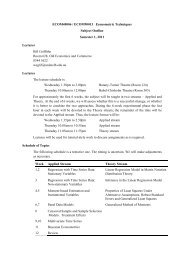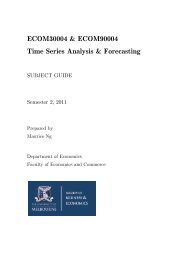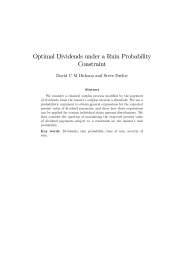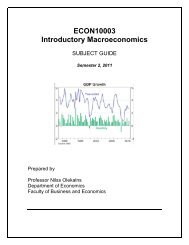A Model of Optimal Corporate Bailouts - Faculty of Business and ...
A Model of Optimal Corporate Bailouts - Faculty of Business and ...
A Model of Optimal Corporate Bailouts - Faculty of Business and ...
Create successful ePaper yourself
Turn your PDF publications into a flip-book with our unique Google optimized e-Paper software.
A.8 Pro<strong>of</strong> <strong>of</strong> Theorem 3Pro<strong>of</strong>: The optimal bailout policy replaces the incumbent manager if <strong>and</strong> only if V n ≥ V o , or:∗2co·en 1e1·(R + S) −2+ (1 − e n 1 )·svn 2 − I1 ≥ e1·(R o + S) − co·eo 21 + (1 − e o 12)·svo 2 − I 1 .The left-h<strong>and</strong> side <strong>of</strong> the inequality is decreasing in c n (since T n 1 is increasing in cn ) <strong>and</strong> the right-h<strong>and</strong>side is independent <strong>of</strong> c n , hence, there is a threshold ¯c such that V n ≥ V o for all c n ≤ ¯c. Furthermore,we have e n 1 > eo 1 <strong>and</strong> V n1 > V o when c n = c o , thus ¯c > c o .A.9 Pro<strong>of</strong> <strong>of</strong> Theorem 4Pro<strong>of</strong>: Lemma 1 continues to hold in the presence <strong>of</strong> general tax revenues, so T ∗ 2condition is satisfied, the government’s problem is given by:= 0. If the firm’s (IR)max V ∗ ∗= eT 11·(R + S) − 0.5·c·e∗21 + (1 − e∗ 1 )·sv 2 − I 1 − a·z,Imposing the (IC) conditions for managerial effort <strong>and</strong>, by Lemma 1, imposing the new budget-balancecondition (BB ′ ) with equality (i.e., z = g − R−T 12·c ·(g + T1 )), the government’s problem can be restatedas: R − T1R − 2 T1R − T1 R(3R + 4S)max V ∗ =(R + S) − 0.5c+ 1 −− I 2 − I 1T 1 2·c2·c2·c8c R − T1− a· g − ·(g + T 1 ) .2·cTaking the derivative <strong>of</strong> V ∗ with respect to T 1 yields:δV ∗ (R + S)/δT 1 = −2·c+ aR2·c − a2·c ·Setting this equal to zero <strong>and</strong> collecting terms yields:T ∗∗1+ (R − T 1)+4cI 2 − R24c(3+2a)R2−S + (a − 0.5)R +8c=0.5 + 2aR(3R + 4S)16c 2 − I 22·c− aT 1c .+ RS2·c − (1 + a)I 2.The second-order condition is δ 2 V ∗ /δT 2 ∗∗1< 0 so T1 maximizes V ∗ .Recall that T ∗ 1in Proposition 1 is the firm-level tax that fully funds the bailout when the government doesnot have access to general tax revenues (z = 0). It is straightforward to show that (i) T ∗∗1is increasingin a, (ii) T ∗∗∗∗1> 0 if a > a, (iii) T1 < T ∗ 1if a < a, <strong>and</strong> (iv) a < a. The comparative statics results followimmediately from the expression for T ∗∗1 . 36
















